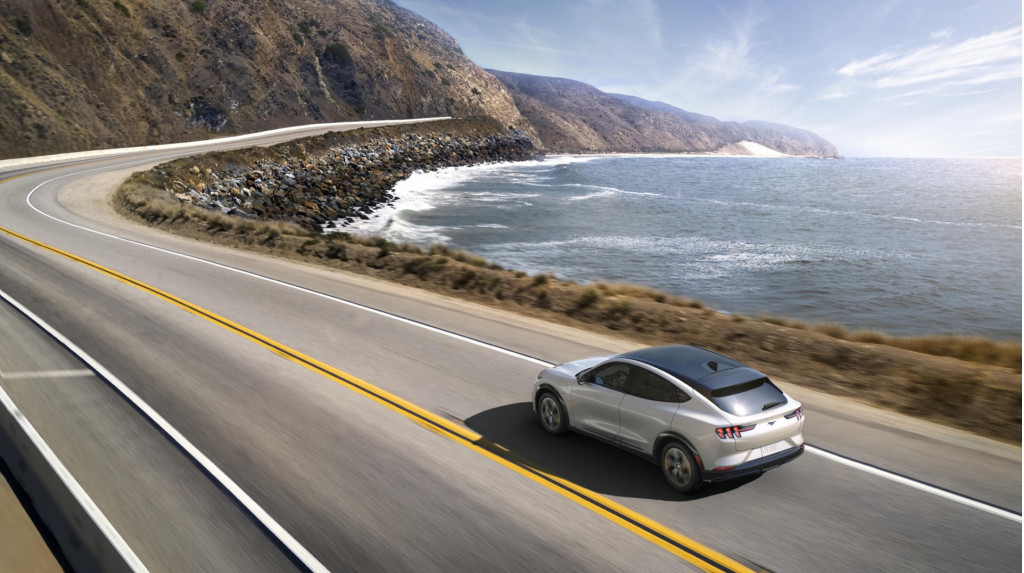With Biden fuel economy rules revealed late Thursday, the EPA expects that “strong hybrid” powertrains will make up just 5% of new sales in 2026, and plug-in hybrids and battery electric vehicles combined will make up just 8% then.
For the past three years, plug-in vehicles have amounted to about 2% of U.S. light-duty sales, although in 2021 they’re on track for 3% nationally.
California and the federal government are expected to work together on vehicle emissions regulation. The proposed Advanced Clean Cars II rules framework for California and other states that mandate EVs—making up about a third of the U.S. new vehicle market—would start with a target of 26% EVs and PHEVs in 2026.

2021 Ford Mustang Mach-E
So in simple math, how does this amount to a firm requirement for any significant amount of EVs elsewhere in the nation by then?
“We believe this increase is reasonable when considering the momentum with which automakers have announced plans to increase their production,” stated the EPA in a release outlining the rules.
Yes, they’re very modest targets and would leave the most dramatic upswing in EV adoption for many states until later in the decade. They served as a reality check mere hours after a splashy all-hands announcement with executives and the UAW, coordinating an executive order for 50% of new U.S. vehicles zero-emission by 2030, and a “shared aspiration” from automakers to achieve 40% combined battery electric, hydrogen fuel-cell, and plug-in hybrid sales by 2030
The administration’s framework would be set for the 2023 through 2026 model years, with future rulemaking potentially extending through MY 2031. Although Biden's targets for the middle part of the decade sound ambitious, the rules themselves save the bulk of the EV transition for late in the decade.
Helping correct course after SAFE
Compared to what the Trump administration’s so-called SAFE standards would have been for the 2023 model year, the Biden standards would bring a 10% emissions improvement for the first year, then a 5% improvement in subsequent years.
According to an EPA fact sheet summing up the rules, that would bring the fleet to an “MPG equivalent” 52.0 mpg (171 grams per mile) in model year 2026, compared to 50.1 mpg (177 g/mi) under the original 2012 Obama standards and 43.3 mpg (205 g/mi) under the current Trump rule. And in actual EPA ratings, that amounts to a fleet average of 38.2 mpg by then under the Biden rules, versus 36.8 mpg under the Obama rules and 32.2 mpg with Trump.

Proposed EPA fleet targets for MY 2023-2026, August 2021
As a chart helps underscore, the Biden rules don’t make up for, let alone catch up to, the Obama-era trajectory. They would actually allow more emissions than the Obama rules through the 2025 model year, under an assumption that those rules would have completely flattened from 2025 to 2026 rather than continuing to tighten.
"Greater stringency" option could be key
In proposed rulemaking, the administration suggested how it might accomplish something closer to remedying the damage incurred by Trump rules in effect this year and next. EPA is seeking comment on a 5-10 g/mi “greater stringency” that would bring the Biden trajectory below the Obama standards sooner.
But that stronger provision hasn’t been written in quite yet. And for now it validates the concerns from environmental groups, recently emphasizing that Biden efficiency and mpg rules would need to be tougher than merely restoring the Obama trajectory, to make up for Trump’s rollback.
“These robust standards are underpinned by sound science and technical expertise, encouraging the development of technology and innovation that will drive America forward into a clean energy future,” said EPA administrator Michael Regan in the release.
The EPA projected the savings to consumers as being between $120 billion and $250 billion through 2050, with up to an additional $140 billion in net benefits from reduced climate change and human health impact.

2021 Volkswagen ID.4 - First drive, Portland OR
The agency cited analysis suggesting automakers would be able to comply with the new standards with an extension of technologies already used in today’s vehicles, plus “modest increases in the numbers of electric vehicles entering the fleet. “These standards provide adequate lead time for manufacturers to comply with reasonable costs,” it said.
The new rules could reduce gasoline consumption by almost 10% by 2050, according to the EPA, with the cumulative emissions avoided by then about equal to a year’s worth of greenhouse-gas emissions from 2019 U.S. petroleum combustion. In all, 2.2 billion tons of CO2 emissions would be avoided through 2050 in having those four years of more efficient vehicles in the fleet.
Same structure introduced with Obama-era standards
They’ll again carry over the footprint-based formula that essentially sets a different standard for each manufacturer’s passenger cars and trucks. It’s a formula that many argue has accelerated the shift to taller, less-efficient SUVs and the discontinuation of passenger cars.

2015 Ford Mustang EcoBoost active grille shutters
There will be a “limited extension” of the current credit system, with automakers allowed to carry over some credits from as early as 2016. Advanced-technology (“off-cycle”) credits are also back with the new rules, and give automakers a boost to their fleet average for including tech like high-efficiency headlamps or solar-reflective paint (or, in the past, grille shutters) that wouldn’t otherwise lead to a direct impact on window-sticker EPA ratings. As anticipated by environmental groups, they’ve been boosted from a 10 g/mi cap to 15 g/mi.
With the federal government and California coordinating rulemaking, we’re eager to see how this plays out—especially in assuring that the EV growth in the interim isn’t only in the California ZEV states.
The EPA will hold virtual public hearings on the new rules and is accepting written comments on them—from you, on that “greater stringency,” perhaps—before September 27.













